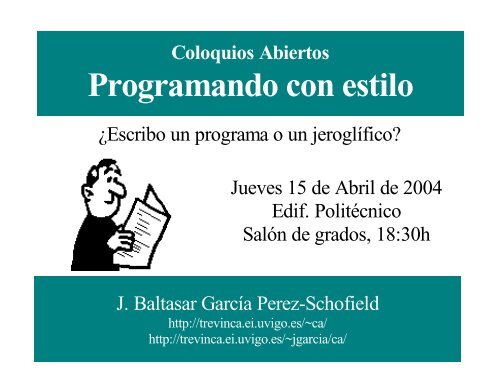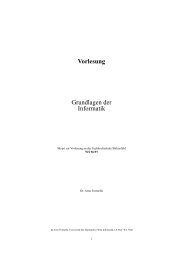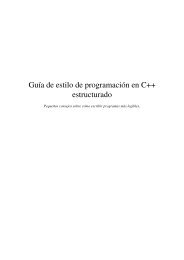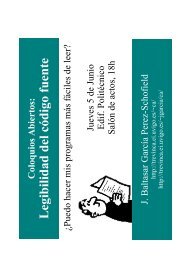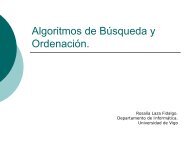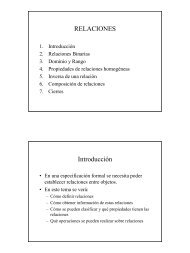Diapositivas de la presentación
Diapositivas de la presentación
Diapositivas de la presentación
Create successful ePaper yourself
Turn your PDF publications into a flip-book with our unique Google optimized e-Paper software.
Coloquios Abiertos<br />
Programando con estilo<br />
¿Escribo un programa o un jeroglífico?<br />
Jueves 15 <strong>de</strong> Abril <strong>de</strong> 2004<br />
Edif. Politécnico<br />
Salón <strong>de</strong> grados, 18:30h<br />
J. Baltasar García Perez-Schofield<br />
http://trevinca.ei.uvigo.es/~ca/<br />
http://trevinca.ei.uvigo.es/~jgarcia/ca/
Introducción (I): La crisis <strong>de</strong>l Software<br />
● Se emplea más tiempo en mantener un programa<br />
que en crearlo por primera vez.<br />
● El mantenimiento implica corrección <strong>de</strong> errores y<br />
ampliación <strong>de</strong> funcionalidad.<br />
● El mantenimiento implica, por tanto, un profundo<br />
estudio <strong>de</strong>l código fuente.<br />
● El software que no se mantiene es aquel que no se<br />
usa.
Introducción (II): Manteniendo el<br />
software<br />
● Es realmente difícil que un solo programador<br />
mantenga una aplicación <strong>de</strong>terminada a lo <strong>la</strong>rgo <strong>de</strong><br />
toda su vida.<br />
● Otros programadores <strong>de</strong>ben ser capaces <strong>de</strong> leer el<br />
código<br />
● Otros programadores <strong>de</strong>ben po<strong>de</strong>r apren<strong>de</strong>r leyendo<br />
código.
Agrupación básica recursiva <strong>de</strong><br />
cualquier programa
Reg<strong>la</strong>s generales <strong>de</strong> estilo en el código<br />
fuente
Normas generales <strong>de</strong> estilo en el código<br />
● Nombres <strong>de</strong> i<strong>de</strong>ntificadores<br />
● Comentarios<br />
● Disposición <strong>de</strong> <strong>la</strong> secuencialidad <strong>de</strong>l programa<br />
● Expresiones<br />
● Disposición <strong>de</strong> los elementos <strong>de</strong> control (aperturacierre<br />
<strong>de</strong> funciones, apertura-cierre <strong>de</strong> bloques)<br />
● Disposición <strong>de</strong> los controles <strong>de</strong> flujo <strong>de</strong>l programa<br />
(if, while).
Nombres <strong>de</strong> i<strong>de</strong>ntificadores<br />
● Tan cortos como sea posible, pero ... tan<br />
informativos como sea posible.<br />
● La nueva técnica <strong>de</strong> moda (Java):<br />
– nombreDeI<strong>de</strong>ntificadorLargo<br />
● Otras técnicas (C++):<br />
– nombre_<strong>de</strong>_i<strong>de</strong>ntificador_<strong>la</strong>rgo
● Por ejemplo:<br />
Nombres <strong>de</strong> i<strong>de</strong>ntificadores<br />
● x, n, i -> bucles o argumentos <strong>de</strong> funciones simples.<br />
● numCaracteres<br />
– numeroCaracteres<br />
– numCars<br />
● nombreUsuario<br />
– nomDeUsuario<br />
– nomUsr
● Un comentario:<br />
Comentarios<br />
– Debe introducirse sólo si es útil<br />
– Debe explicar, no complicar<br />
– No <strong>de</strong>be insultar <strong>la</strong> inteligencia <strong>de</strong>l lector<br />
int areaRectangulo = <strong>la</strong>do1 * <strong>la</strong>do2 // cálculo <strong>de</strong>l area<br />
x = PI * r * r; // cálculo <strong>de</strong>l área <strong>de</strong>l círculo<br />
// PI es 3.1415927
Comentarios (II)<br />
● Dos tipos básicos <strong>de</strong> comentarios:<br />
– "Encima"<br />
● Los más recomendables (explican un bloque)<br />
– "A <strong>la</strong> <strong>de</strong>recha"<br />
● Siempre cortos<br />
● Cuidado con los márgenes (no pasar <strong>de</strong> 80).<br />
{ Cálculos previos al ren<strong>de</strong>ring }<br />
areaRectangulo := <strong>la</strong>do1 * <strong>la</strong>do2 { en cms }
Secuencialidad<br />
● Dispónganse <strong>la</strong>s instrucciones <strong>de</strong> un programa en<br />
párrafos<br />
● Cada párrafo pue<strong>de</strong> llevar un comentario "arriba"<br />
● Nunca una función <strong>de</strong>be tener más texto que una<br />
página impresa, a no ser que se trate <strong>de</strong> acciones<br />
repetitivas.<br />
● Trátese <strong>de</strong> seguir el esquema: inicialización, proceso<br />
(normalmente, un bucle), finalización<br />
● Cortar <strong>la</strong>s líneas antes <strong>de</strong> <strong>la</strong> columna 80
Secuencialidad <strong>de</strong>l programa<br />
● Estructura básica:<br />
iterator it = l->begin();<br />
while(it != NULL)<br />
}<br />
{<br />
if (*it == x) {<br />
}<br />
break;<br />
it = it->next();<br />
return it;
Secuencialidad <strong>de</strong>l programa<br />
// Colocar <strong>la</strong> ventana<br />
Left = 0;<br />
Height = 0;<br />
Show();<br />
// Activar los botones<br />
Boton1->Enabled = true;<br />
Boton2->Enabled = true;
Var<br />
Secuencialidad <strong>de</strong>l programa:<br />
<strong>de</strong>c<strong>la</strong>ración <strong>de</strong> variables<br />
i : integer;<br />
area : real;<br />
longitud: real;<br />
nombre : string;<br />
edad : integer;<br />
int i;<br />
int x;<br />
int y;<br />
string edad;<br />
double area;<br />
int x, *ptr; // NO
● c = a * b + c<br />
Expresiones Matemáticas<br />
– ... era (a * b) + c<br />
– ... era a * (b + c)<br />
● cars = lineas * caracteresPorLinea + espaciosMargen<br />
– ... ¡era a *(b + c)!<br />
● Sin embargo, el código ejecutable generado es<br />
exactamente el mismo con paréntesis que sin ellos:<br />
● ((a * b) + c)<br />
● a * b + c
Expresiones Matemáticas (II)<br />
● ¿Don<strong>de</strong> cortar una línea con una expresión <strong>la</strong>rga?<br />
– Antes <strong>de</strong> una subexpresión<br />
– Antes <strong>de</strong> un operador<br />
– Antes <strong>de</strong> un paréntesis<br />
int x = ((a * b + c) / (c * d * d))<br />
;<br />
+ (a / (b * c))<br />
+ ((3.1451927 * b) + d)
● Por ejemplo:<br />
Otras expresiones<br />
while(*ptrDestino++=*ptrOrigen++);<br />
while(it != NULL)<br />
it = it->sig == NULL? NULL :<br />
it->sig->iterador;
● Añadiendo unos paréntesis:<br />
Otras expresiones(II)<br />
while(*(ptrDestino++)=*(ptrOrigen++));<br />
while(it != NULL)<br />
it = ((it->sig == NULL)? NULL :<br />
(it->sig->iterador));
● Versión real legible:<br />
Otras expresiones(III)<br />
while(*ptrOrigen != 0) {<br />
}<br />
*ptrDestino = *ptrOrigen;<br />
++ptrOrigen;<br />
++ptrDestino;
Otras expresiones(IV)<br />
● Versión real legible:<br />
while(it != NULL)<br />
{<br />
}<br />
if (it->sig != NULL)<br />
it = it->sig->iterador;<br />
else it = NULL;
Bloques<br />
● La forma más recomendable <strong>de</strong> colocar los bloques<br />
es marcar el inicio y el fin <strong>de</strong> un bloque en líneas<br />
separadas<br />
if (divisor 0) then<br />
begin<br />
resultado := divi<strong>de</strong>ndo / divisor;<br />
writeln(resultado);<br />
end;
● Son casi siempre poco recomendables porque introducen<br />
confusión. La línea tien<strong>de</strong> a ser ilegible.<br />
● Recuér<strong>de</strong>se que los bloques <strong>de</strong> una so<strong>la</strong> línea sin marcas <strong>de</strong><br />
bloque son una posibilidad, no una obligación.<br />
if (divisor != 0) {<br />
}<br />
Bloques <strong>de</strong> una so<strong>la</strong> línea<br />
System.out.print(divi<strong>de</strong>ndo/divisor);
Estructuras <strong>de</strong> flujo y repetición<br />
● Disposición <strong>de</strong> <strong>la</strong>s condiciones en un if() o en un<br />
while().<br />
– Una subcondición por línea, comenzando por el<br />
juntor. Si es necesario, una condición pue<strong>de</strong><br />
llevar un comentario "a <strong>la</strong> <strong>de</strong>recha".<br />
– Si existen varias subexpresiones condicionales,<br />
se pue<strong>de</strong>n in<strong>de</strong>ntar respecto a <strong>la</strong> expresión<br />
principal.<br />
– Elimina <strong>la</strong> posibilidad <strong>de</strong> que el bloque <strong>de</strong> código<br />
<strong>de</strong> una so<strong>la</strong> línea se indique sin marcas <strong>de</strong><br />
bloque.
Estructuras <strong>de</strong> flujo y repetición<br />
if (not(eof(fichEntrada))<br />
and (bytesLeidos < 0<br />
or bytesLeidos > 1000)<br />
and caracter FINAL) then<br />
begin<br />
end;<br />
read(fichEntrada, caracter);
Estructuras <strong>de</strong> flujo y repetición y<br />
bloques <strong>de</strong> una so<strong>la</strong> línea<br />
● Deben evitarse siempre:<br />
if (not(eof(fichEntrada))<br />
and (bytesLeidos < 0<br />
or bytesLeidos > 1000)<br />
and caracter FINAL) then<br />
read(fichEntrada, caracter); {ilegible}
Reg<strong>la</strong>s semánticas <strong>de</strong> escritura <strong>de</strong><br />
código<br />
¿Qué significa lo que escribes?<br />
¡Dame una pista!
Nombres <strong>de</strong> variables según uso<br />
● Devolución <strong>de</strong> un valor:<br />
c<strong>la</strong>ss Punto {<br />
}<br />
// ...<br />
public String toString()<br />
{<br />
}<br />
String toret = "";<br />
toret += "(" + x + ", " + y + ")";<br />
return toret;
Nombres <strong>de</strong> funciones significativos<br />
● Los nombres <strong>de</strong> métodos <strong>de</strong>ben sugerir qué hacen:<br />
int getEdad(Persona);<br />
bool esPalindromo(const string &);<br />
● Evítesen nombres como los siguientes:<br />
int procesar(const FILE *&);<br />
string pasarAuxiliar(const string &);
Un ejemplo real
El juego <strong>de</strong>l Nim
● La estrategia <strong>de</strong>l juego se basa en dos métodos, en<br />
un programa en Java:<br />
c<strong>la</strong>ss Nim {<br />
}<br />
bool movimiento_chachi(Tablero t) {<br />
}<br />
// ...<br />
bool movimiento_chungo(Tablero t) {<br />
}<br />
// ...<br />
El juego <strong>de</strong>l Nim
● "movimiento_chachi()" prueba si un movimiento le<br />
lleva a ganar el juego:<br />
bool movimiento_chachi(Tablero t) {<br />
}<br />
// Proponer un movimiento<br />
// ...<br />
if (movimiento_chungo(t)) {<br />
}<br />
// ...<br />
"movimiento_chachi()"<br />
// Realizar el movimiento
● "movimiento_chungo()" comprueba si un<br />
movimiento es malo ... ¿no?<br />
bool movimiento_chungo(Tablero t) {<br />
}<br />
if (t.esVacio()<br />
{<br />
"movimiento_chungo()"<br />
|| movimiento_chachi(t))<br />
return false;<br />
} else return true;
● "movimiento_chachi()" pue<strong>de</strong> ser modificado,<br />
eliminando "movimiento_chungo()":<br />
bool hayMovimientoGanador(Tablero t) {<br />
}<br />
// Proponer un movimiento<br />
// ...<br />
if (!(t.esVacio())<br />
}<br />
&& !(hayMovimientoGanador(t))) {<br />
// ...<br />
hayMovimientoGanador()<br />
// Realizar el movimiento
Programas autodocumentados<br />
Concurso Internacional "C ofuscado"<br />
http://www.es.ioccc.org/main.html
#<strong>de</strong>fine processor x86<br />
#inclu<strong>de</strong> <br />
#inclu<strong>de</strong> <br />
#<strong>de</strong>fine l int*<br />
#<strong>de</strong>fine F char<br />
struct stat t;<br />
#<strong>de</strong>fine c return<br />
#<strong>de</strong>fine I (P+=4,*L(P-4,0))<br />
#<strong>de</strong>fine G (signed F)E(*L(P++,0))<br />
#<strong>de</strong>fine C(O,D)E (D[B+V(010)/4+O*10])<br />
#<strong>de</strong>fine U R[4]=E(V(17)-4),*(l)V(021)=<br />
F M [99],Q[99],b[9999],*ss,*d=b,*z;<br />
#<strong>de</strong>fine O =(n=*(l)V(021),R[4]=E(V(17)+4),n)<br />
#<strong>de</strong>fine p(a,b,c) system((sprintf(a,b,k[1]),c)),z<br />
#<strong>de</strong>fine g (y/010&7)<br />
#<strong>de</strong>fine R (B+13)<br />
#<strong>de</strong>fine x86 (F*)in<strong>de</strong>x\<br />
(ss+V(i ),0100)<br />
#<strong>de</strong>fine D(y,n,a,m,i,c )d+=sprintf( d,y,n,a,m,i,c ),(F*\<br />
) P<br />
l B,i,n,a,r,y ,<br />
P ;<br />
#<strong>de</strong>fine Tr(an,sl,at,or) l an##i(d,sl){ c at? an##i(d,r):or; } \<br />
l an(d, sl){ c \<br />
r=V(014 )&63,an##i(d,sl); }<br />
#<strong>de</strong>fine add(Ev,Gv) + ...<br />
main (char *ck, char **k) { exit(E((ck?main((z?(stat(M,&t)?<br />
P+=a+'{'?0:3:execv(M,k),a=G,i=P,y=G&255,sprintf(Q,y/'@' ...<br />
}
#inclu<strong>de</strong> <br />
int l;int main(int o,char **O,<br />
int I){char c,*D=O[1];if(o>0){<br />
for(l=0;D[l ];D[l<br />
++]-=10){D [l++]-=120;D[l]-=<br />
110;while (!main(0,O,l))D[l]<br />
+= 20; putchar((D[l]+1032)<br />
/20 ) ;}putchar(10);}else{<br />
c=o+ (D[I]+82)%10-(I>l/2)*<br />
(D[I-l+I]+72)/10-9;D[I]+=I
(<br />
){z<br />
k=0,l<br />
=0,n,x<br />
XQueryPointer(i<br />
,XRootWindow (i,j),&m,<br />
&m,&o,&p,&n,&n,( ghj)&n),(o<br />
>=s(g)||s(o<br />
)=h||p=s(g)||o=h||s(p)
Bibliografía<br />
● Eckel (2000). Thinking in C++. Prentice Hall<br />
● Caro, Ramos, Barceló (2002). Introducción a <strong>la</strong><br />
programación con orientación a objetos. Prentice-<br />
Hall<br />
● Documentación <strong>de</strong> Microsoft:<br />
http://msdn.microsoft.com/library/<strong>de</strong>fault.asp?url=/l<br />
ibrary/en-us/stg/stg/coding_style_conventions.asp<br />
● Documentación <strong>de</strong> Sun:<br />
http://java.sun.com/docs/co<strong>de</strong>conv/html/Co<strong>de</strong>Conv<br />
TOC.doc.html
Coloquios Abiertos<br />
Programando con estilo<br />
¿Escribo un programa o un jeroglífico?<br />
Jueves 15 <strong>de</strong> Abril <strong>de</strong> 2004<br />
Edif. Politécnico<br />
Salón <strong>de</strong> grados, 18:30h<br />
J. Baltasar García Perez-Schofield<br />
http://trevinca.ei.uvigo.es/~ca/<br />
http://trevinca.ei.uvigo.es/~jgarcia/ca/


